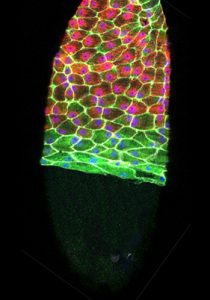Eggs pop out of ovaries. But what propels them has been unknown. Now, researchers from the University of Connecticut explain in the September 18 issue of PNAS: tiny muscle-like fibers in the ovary’s cells squeeze the egg out.
Before an animal’s egg can be fertilized—any kind of animal, whether human, chicken, fish, or fruit fly—it needs to emerge from an ovary. This is called ovulation. The egg ripens inside a cocoon of cells in the ovary, called a follicle. Right at ovulation, the follicle somehow breaks open and the egg emerges. If the follicle doesn’t break open, there’s no ovulation, and the egg cannot be fertilized.
Some sort of force is needed to break open the follicle and release the egg. But measuring force in something as tiny as a cell is difficult. Especially when scientists are unsure what is even generating the force.

An ovarian follicle in the process of rupture. The pale green shadow toward the bottom of the image is the egg, emerging from the ruptured end of the follicle. (Courtesy of Stella E. Cho, Sun laboratory, UConn)
UConn physiologist and geneticist Jianjun Sun, a professor in the Department of Physiology and Neurobiology, suspected that actin and myosin—the building blocks of muscles—might play a role in ovulation. Sun studies ovulation with an eye to find better methods of birth control, and has done many subtle experiments to better understand the interplay of egg, follicle, and ovary. He and doctoral candidate Stella Cho decided to look at the process in fruit flies. Female flies ovulate about twice an hour throughout most of their lives, making them convenient test subjects.
Actin is a long fiber, and myosin like a tiny motor that moves along the fiber and causes it to contract. The researchers used fluorescent dyes to mark the actin and myosin in the egg follicle cells in the fruit flies’ ovaries. They found both were disorganized in the follicle cells, which was expected. What was less expected was that, when the egg was ripe, the actin and myosin would concentrate in the follicle cells’ walls and contract. This caused the cells to change shape around the egg and push the egg toward the outside edge.
“Once you make the follicle cell taller and less surface area covering the egg, it pushes the egg out…and leads to rupture,” says Sun. Eggs are essentially expelled from the follicle by squeezing, much like squeezing a tube of toothpaste.
Sun and Cho also found they could stop the follicle rupture by blocking the signaling molecule that causes the actin and myosin to assemble and contract. The follicles retained the eggs instead. Normal fruit flies lay 50 to 60 eggs a day; the fruit flies with the blocked signal laid only 10 to 15, a huge decrease.
The process of ovulation is very similar across animal families, so what happens in fruit flies is very likely to happen in mammals such as humans, too. Sun’s lab hopes to pursue this research further to understand human ovulatory disorders and design contraceptive compounds to inhibit the ovulation process.



